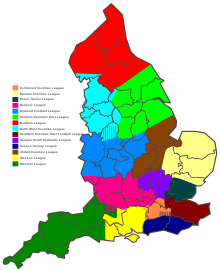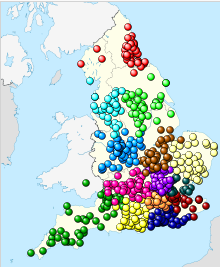The English football league system, besides known as the football pyramid, is a series of complect leagues for men ‘s association football clubs in England, with five teams from Wales, one from Guernsey, one from Jersey and one from the Isle of Man besides competing. The system has a hierarchical format with promotion and delegating between leagues at different levels, allowing even the smallest clubhouse the theoretical possibility of ultimately rising to the identical top of the system. There are more than 140 individual leagues, containing more than 480 divisions. [ 1 ] The demand numeral of golf club varies from year to year as clubs join and leave leagues, unite, or fold all in all, but an estimate average of 15 clubs per division implies that more than 7,000 teams of closely 5,300 clubs are members of a league in the English men ‘s football league arrangement.
Reading: English football league system
As there are no official definitions of any level below 11, any references to the social organization at charge 12 and below should not be regarded as authoritative. The pyramid for women ‘s football in England runs individually to nine tiers and some England-based men ‘s clubs play outside the English football league arrangement .
history [edit ]
The worldly concern ‘s first association football league, named just The Football League, was created in 1888 by Aston Villa clubhouse conductor William McGregor. It was dominated by those clubs who had supported professionalism. The twelve founding members were six from Lancashire ( Accrington, Blackburn Rovers, Burnley, Bolton Wanderers, Everton and Preston North End ) and six from the Midlands ( Aston Villa, Derby County, Notts County, Stoke, West Bromwich Albion and Wolverhampton Wanderers ) .
About the system [edit ]
 A diagram showing the areas covered by level 9 of the English football league system .
A diagram showing the areas covered by level 9 of the English football league system . Map showing the location of teams in levels 9–10 of the English football league system in 2011–12 The system consists of a pyramid of leagues, bound together by the principle of promotion and relegation. A certain number of the most successful clubs in each league can rise to a higher league, whilst those that finish the season at the bottom of their league can find themselves sinking down a level. In addition to sporting performance, promotion is normally contingent on meeting criteria set by the higher league, specially concerning appropriate facilities and finances. In theory, it is potential for a humble local anesthetic amateurish baseball club to achieve annual promotions and within a few years rise to the pinnacle of the english game and become champions of the Premier League. While this may be improbable in practice ( at the identical least, in the short run ), there surely is significant campaign within the pyramid. The top five levels contain one part each and are nationally in setting. Below this, the levels have increasingly more parallel leagues, with each covering increasingly smaller geographic areas. many leagues have more than one division. At the lower levels the being of leagues becomes intermittent, although in some of the more dumbly populate areas there are leagues more than twenty layers below the Premier League. [ 2 ] There are besides leagues in versatile parts of the state which are not officially partially of the arrangement as they do not have formal agreements with other leagues, but are recognised at versatile levels by county football associations. Clubs from these leagues may, if they feel they meet the appropriate standard of play and have desirable facilities, apply to join a league which does form partially of the system. The six levels immediately below the Premier League and three-level English Football League are known as the National League System and come under the jurisdiction of The Football Association. In May 2014 The FA announced probationary plans for a modern division between the English Football League and the National League which would include “ B ” team of higher-level clubs. They late reneged on the plan to include Premier League “ B ” team in the new division [ 3 ] and soon thereafter scrapped the mind all in all. [ 4 ] The English football league system does not include the amateur translation of the plot frequently called Sunday league football. These leagues are independent entities with no promotion or delegating involving the football pyramid. however, some Sunday league clubs have been known to join pyramid leagues if they desire to progress higher. There are besides some Saturday leagues which are not officially region of the pyramid, although teams frequently leave these for pyramid leagues .
Map showing the location of teams in levels 9–10 of the English football league system in 2011–12 The system consists of a pyramid of leagues, bound together by the principle of promotion and relegation. A certain number of the most successful clubs in each league can rise to a higher league, whilst those that finish the season at the bottom of their league can find themselves sinking down a level. In addition to sporting performance, promotion is normally contingent on meeting criteria set by the higher league, specially concerning appropriate facilities and finances. In theory, it is potential for a humble local anesthetic amateurish baseball club to achieve annual promotions and within a few years rise to the pinnacle of the english game and become champions of the Premier League. While this may be improbable in practice ( at the identical least, in the short run ), there surely is significant campaign within the pyramid. The top five levels contain one part each and are nationally in setting. Below this, the levels have increasingly more parallel leagues, with each covering increasingly smaller geographic areas. many leagues have more than one division. At the lower levels the being of leagues becomes intermittent, although in some of the more dumbly populate areas there are leagues more than twenty layers below the Premier League. [ 2 ] There are besides leagues in versatile parts of the state which are not officially partially of the arrangement as they do not have formal agreements with other leagues, but are recognised at versatile levels by county football associations. Clubs from these leagues may, if they feel they meet the appropriate standard of play and have desirable facilities, apply to join a league which does form partially of the system. The six levels immediately below the Premier League and three-level English Football League are known as the National League System and come under the jurisdiction of The Football Association. In May 2014 The FA announced probationary plans for a modern division between the English Football League and the National League which would include “ B ” team of higher-level clubs. They late reneged on the plan to include Premier League “ B ” team in the new division [ 3 ] and soon thereafter scrapped the mind all in all. [ 4 ] The English football league system does not include the amateur translation of the plot frequently called Sunday league football. These leagues are independent entities with no promotion or delegating involving the football pyramid. however, some Sunday league clubs have been known to join pyramid leagues if they desire to progress higher. There are besides some Saturday leagues which are not officially region of the pyramid, although teams frequently leave these for pyramid leagues .
structure [edit ]
At the top is the single division of the Premier League ( level 1, which is often referred to as the “ top-flight ” ), containing 20 clubs, all of which, up to the 2010–11 season, were based in England. however, two Welsh teams ( Swansea City and Cardiff City ) have since played in the league. Below the Premier League is the english Football League ( EFL ) ( once ‘the Football League ‘ ), which is divided into three divisions of 24 clubs each : The Championship ( charge 2 ), League One ( level 3 ), and League Two ( horizontal surface 4 ). The 20 clubs in the Premier League and 72 clubs in the English Football League are all full-time master club. The Premier League members are distillery frequently referred to as ‘League ‘ clubs because, before the establishment of the Premier League in 1992, the Football League, as it was called then, included all 92 clubs, in four divisions. Clubs outside this group are referred to as ‘non-League ‘ clubs ( i.e. non-EFL ), although they excessively play their football in league competitions. The top tier of non-League football is the National League. It contains a national division ( National League ) ( level 5 ) of 24 clubs, and is the lowest grade with a individual nationally league. This division, like the four above, is a full-time professional competition, although some promote clubs retain half-time condition. There are two divisions at level 6, covering the north ( National League North ) and confederacy ( National League South ), with 22 clubs each. Some of these clubs are full-time master and the others are semi-professional. Below the National League, some of the stronger clubs are semi-professional, but continuing down the tiers, soon all the clubs are amateur. Lower-level leagues besides tend to cater to increasingly smaller geographic regions. next down from the National League are four regional leagues, each associated with different geographic areas, although some overlap exists. They are the Northern Premier League ( which covers the north of England ), Southern Football League Central ( which covers the Midlands ), Southern Football League South ( which covers south and southwest of England, with one baseball club from South Wales ) and the Isthmian League ( which includes clubs from the southeast of England a well as Guernsey from the Channel Islands ). All of the leagues have Premier Divisions of 22 teams ( degree 7 ). Below these, and rip by region, both Southern Football Leagues have two parallel divisions of 20 teams ( level 8 ). The isthmian League and Northern Premier League have two parallel level 8 divisions of 20 teams each american samoa well.
Read more: Lille OSC
flush 9 contains the acme divisions of a bombastic group of fourteen sub-regional leagues. Each of these leagues has a unlike divisional setup, but they all have one thing in common : there are however more leagues below them, each covering smaller and smaller geographic levels .
promotion and relegation rules for the peak eight levels [edit ]
 [5] Approximate areas for the stream four-division floor 7 ( Step 3 ), from 2018–19 onwards .
[5] Approximate areas for the stream four-division floor 7 ( Step 3 ), from 2018–19 onwards .
- Premier League (level 1, 20 teams): The bottom three teams are relegated.
- English Football League Championship (level 2, 24 teams): Top two automatically promoted; next four compete in the play-offs, with the winner gaining the third promotion spot. The bottom three are relegated.
- English Football League One (level 3, 24 teams): Top two are automatically promoted; next four compete in play-offs, with the winner gaining the third promotion spot. The bottom four are relegated.
- English Football League Two (level 4, 24 teams): Top three teams are automatically promoted; next four compete in play-offs, with the winner gaining the fourth promotion spot. The bottom two are relegated.
- National League (level 5, 24 teams): The champions are promoted; next six compete in play-offs, with the winner gaining the second promotion spot. The bottom four are relegated to either North or South division as appropriate.
- National League North and National League South (level 6, 22 teams each, increasing to 24 from the 2023–24 season, running in parallel): The champions in each division are automatically promoted; next six teams in each division compete in play-offs, with the play-off winner in each division getting the second promotion spot, with four teams qualifying to the National league in total. For 2021–22, the bottom team in each division relegated to either Northern Premier League, Southern League or Isthmian League as appropriate. If, after promotion and relegation, the number of teams in the North and South divisions is not equal, one or more teams are transferred between the two divisions to even them up again based on geographic factors.
- Northern Premier League Premier Division, Southern Football League Central Division, Southern Football League South Division and Isthmian League Premier Division (level 7, 22 teams each, leagues running in parallel): The champions in each division are automatically promoted; next four teams in each division compete in play-offs, with the play-off winners also promoted. The bottom four teams in each division relegated to a level 8 division as appropriate. If, after promotion and relegation, the number of teams in the divisions is not equal, one or more teams are transferred among the four divisions to even them up again.
- Northern Premier League Division One East, Northern Premier League Division One Midlands, Northern Premier League Division One West, Southern Football League Division One East, Southern Football League Division One West, Isthmian League Division One North, Isthmian League Division One South Central and Isthmian League Division One South East (level 8, running in parallel, 20 teams in each division): The champions in each division are automatically promoted; next four teams in each division compete in play-offs, with the play-off winners also promoted. The third or fourth-from-bottom team in each division plays a level 9 runner-up club in an inter-step play-off match, with the losing team from level 8 relegated to a level 9 division as appropriate. If, after promotion and relegation, the number of teams in the divisions is not equal, one or more teams are transferred between the divisions to even them up again.
Cup eligibility [edit ]
Being members of a league at a particular grade besides affects eligibility for Cup, or single-elimination, competitions .
In the case of the FA Cup and the FA Vase, some of the clubs in the lowest level in each do not compete. For exemplify, the 2017–18 FA Cup saw 77 teams compete from level 10 out of the 338 in entire at that level. Below level 11 the pyramid becomes regional and the cups become consequently regional. Further down the pyramid is split on a county basis, counties having their own cups accordingly. This excludes some tournaments marked “ aged Cups ”, which frequently are competitions between teams representing top professional clubs in a given zone, and may be little more than derbies, such as the Gloucestershire Cup, which originally included all teams in Gloucestershire, but then came to be contested as a Bristol bowler hat .
The system [edit ]
For details of changes made below the level of the English Football League, see History of the English non-League football system Level one in the pyramid, the top division of English football, is run by the Premier League ( which gives its name to the competition in that division ), the winners of which are regarded as the champions of England. Levels two to four are run by the English Football League. together, these four divisions make up what is known as “ league football ”. The leagues below floor four are classed as “ non-League football ”, meaning they are outside the EFL. The leagues at levels five to ten comprise the National League System ( NLS ), and come under the direct jurisdiction of the Football Association. The top level ( level 5 ) of the NLS is known as “ step 1 ”, the adjacent ( level 6 ) as “ footstep 2 ”, and so on. Until 2020, level 11 divisions were designated as “ step 7 ”, but that year were re-designated as “ Regional Feeder Leagues ” .
The system is merely defined a far as level 11. What follows is a conceptional social organization, based on which league promote and relegate to each other .
See besides [edit ]
Notes [edit ]
References [edit ]
Read more: France national football team
